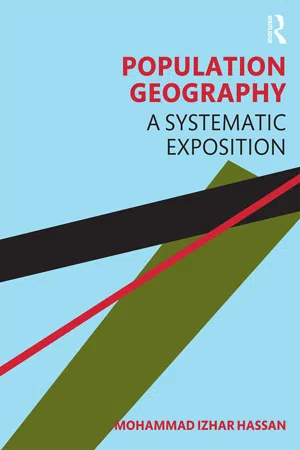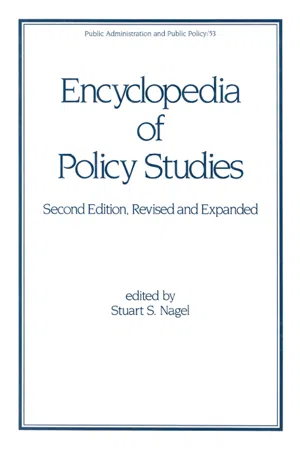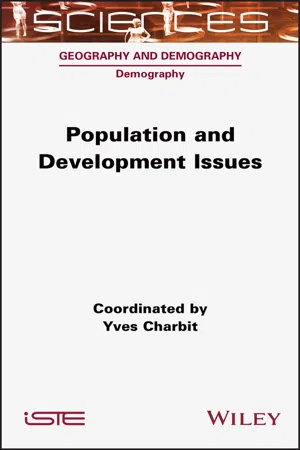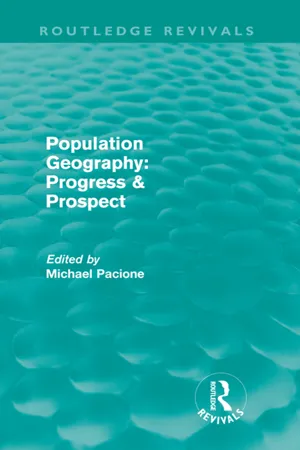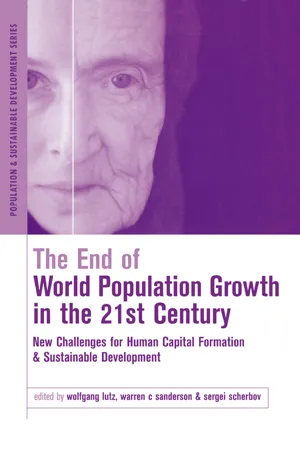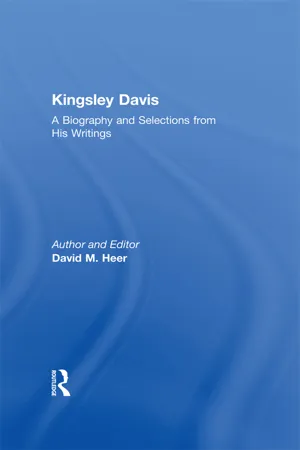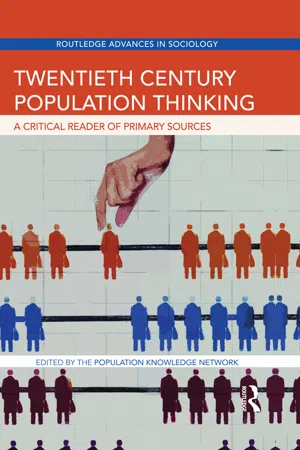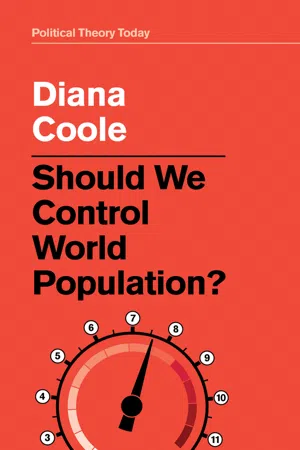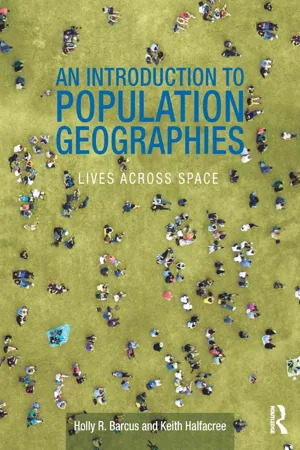Geography
Population Policies
Population policies refer to government strategies and measures aimed at influencing the size, distribution, and composition of a population. These policies can include initiatives to control birth rates, encourage immigration, or address population aging. They are often implemented to achieve economic, social, or environmental objectives and can involve a range of interventions such as family planning programs, incentives for childbirth, or immigration quotas.
Written by Perlego with AI-assistance
Related key terms
10 Key excerpts on "Population Policies"
- eBook - ePub
Population Geography
A Systematic Exposition
- Mohammad Izhar Hassan(Author)
- 2020(Publication Date)
- Routledge India(Publisher)
15 Population policyThe term ‘population policy’ refers to a set of government actions – legislative and administrative – which intend to influence, alter or modify some aspects of population (Chaubey, 2001:9). The United Nations has defined population policy as ‘measures and programmes designed to the achievement of economic, social, demographic, political and other collective goals through affecting critical demographic variables’. In addition to the specifically designed measures, population policy also includes those aspects of overall public policy of a country that affect its demographic attributes. Thus, population policy embraces both direct as well as indirect measures that influence demographic variables for the achievement of desired national goals. In many cases, a population policy is not explicitly stated, but is found contained in programmes launched by the government, or in legislative measures, which are adopted by it (Chaubey, 2001:9). Important to note that in most of the cases, when it is explicitly stated, attention is focussed upon regulating the size of population. Nevertheless, concern regarding the composition and geographical distribution of population also forms a crucial part in a population policy. The desired national social, economic and political goals of a country can be achieved through one or more of the three components of population change – fertility, mortality and migration. Needless to say that through these components, not only the size and numbers but also the composition and geographic distribution of population in a country can be regulated in a desired direction.Government concern over population issues is not a phenomenon of modern times alone. Even during the ancient periods, state interventions in the form of laws or decrees governing size and growth of population existed in some of the earliest civilisations in the world. Ancient Greeks, for instance, were particularly concerned with the size and quality of their populations. Similarly, early Romans, characterised by a fertility cult, had state-sponsored provisions of a number of privileges to married couples with children, and additional financial burdens in the form of taxes to childless couples and unmarried persons. These provisions were aimed at encouraging procreation. Later, under the influence of mercantilism, which equated power and prosperity with large size of population, most of the European countries adopted measures encouraging marriage and procreation. While immigration was always encouraged, emigration was completely banned under the state law. The pro-natalist population policy reached a climax in some of the European countries like Germany and Italy during the intervening period between the two world wars. Closely linked with the political and territorial ambitions, the populationist policies were implemented in the form of certain rewards and incentives to the families with a large number of children while birth control measures were almost suppressed. A similar policy existed in Japan also during the period. All the measures reflected the drive for large native and racially ‘pure’ populations. - eBook - ePub
- Stuart Nagel(Author)
- 2020(Publication Date)
- CRC Press(Publisher)
Aside from the difficulty of defining policy precisely, there are problems unique to the subject of population. For present purposes, a rigorous definition of population policy is not essential, nor need we review the full range of definitional issues that students of population policy have raised. After a search of 34 authors writing between 1940 and 1975, Corsa and Oakley (1979) found consensus on the following elements: Some demographic effect is intended or produced, governments participate in some way, indirect as well as direct means are included, and the concern is population-influencing rather than population-responsive policies. Taking into account the varying usage and these common elements, they offer the following definition: Population policy consists of “those actions of government that affect or attempt to affect the balance between births, deaths, and migration of human beings” (p. 156).This a fairly inclusive definition. It allows for unintended consequences of government action and indirect policy impact on components of a nation’s population and does not specify how purposive, sustained, or coherent the actions of government need be. Miller and Godwin (1977) expand the scope of population policy further. It should include, they argue, “something a government chooses to do or not to do” about population problems. Thus “nondecisions,” decisions not to take action, are considered important. By not taking action on population, governments allow other influences (e.g., private decision making) to determine population events.Such broad definitions are needed to capture much of what the United States and other nations have done (and not done) about population problems. At the same time, for many purposes one needs to differentiate between explicit Population Policies having as their major goal the achievement of particular demographic effects (e.g., lower fertility) and other policies, such as the regulation of abortion, that have only indirect and/or unintended population impacts. The United States has never adopted an explicit or comprehensive national population policy, but a variety of more limited policies affecting population trends have been enacted in the last several decades.II. WORLD POPULATION TRENDS AND POLICY IMPLICATIONS
Prior to examining U.S. population trends and policy actions, an overview of demographic developments on a worldwide basis—in developing as well as developed nations—is useful. The exercise helps to place U.S. population policy issues into the broader context in which they must be assessed.The major population trend is one of rapid growth. The extraordinary modern acceleration of growth began around 1750. Prior to that time, human history was characterized by a relatively stable or very slowly growing population. By 1800, however, the world population rose to 1 billion people, by 1900 to 1.7 billion, and by 1950 to 2.5 billion (Coale, 1974). In October 1992, it stood at 5.5 billion, or more than twice as large as it was only 40 years earlier (United Nations, 1992). - eBook - ePub
- Yves Charbit(Author)
- 2022(Publication Date)
- Wiley-ISTE(Publisher)
actions taken explicitly or implicitly by public authorities, in order to prevent, delay, or address imbalances between demographic changes, on the one hand, and social, economic, [environmental] and political goals, on the other” (May 2012, p. 2). The ultimate goal of Population Policies is to adjust the population size and age structure to the needs and aspirations of the people. However, there is an ongoing debate about whether and how public authorities should intervene in population patterns and trends and, by implementing Population Policies, correct the imbalances caused by the increase or decrease of population and changes in the age structures. Despite a rather large consensus in favor of population interventions, some scholars have argued that it might be better to let natural and self-regulatory mechanisms, if any, do their work (Demeny 1986). However, other researchers have questioned the effectiveness and even the usefulness of Population Policies (Vallin 2016).Nonetheless, there has always been a large consensus in favor of policy interventions to reduce mortality. Furthermore, recent decades have also seen the strengthening of arguments in favor of fertility reduction and voluntary family planning, although some SSA governments have been reluctant to promote large-scale family planning programs (May 2012, 2017a). On the contrary, there is much less consensus in the more developed countries regarding the effectiveness of pronatalist policies, which public authorities have often been reluctant to implement. Moreover, population distribution policies, that is, programs to relocate populations in order to reduce population pressure in the migrants’ regions of origin, have been controversial (such a transmigration program was implemented in Indonesia between 1974 and 1994; see May (2012)). It should be kept in mind that demographic trends are essentially the result of decisions people make as couples or as individuals, with the overall aim being the achievement of household and/or personal goals. At the societal level, however, these individual decisions can have adverse or positive effects, which economists have labeled externalities. Negative externalities result when societal costs are out of line with those that are taken into account by individuals, that is, when the costs to society are greater than the costs supported by individuals. For example, high fertility levels may bring wealth and power to some families, but jeopardize the well-being of the community and its physical environment by depleting natural resources, causing deforestation in the case of agrarian societies, or aggravating unemployment, poverty and chaotic urbanization in the case of more industrialized societies (Pebley 1998). - Michael Pacione(Author)
- 2013(Publication Date)
- Routledge(Publisher)
Geographers have made a much greater contribution to debates on the whole range of policies and programmes which may be described generally as distribution, redistribution and migration policies. This applies to both developed and developing nations. No attempt is made here to provide a systematic review even of the work on population redistribution and immigration in Britain. There have been several recent reviews of migration theory by geographers (White and Woods, 1980; Jones, 1981; Woods, 1982), and these and others have also examined redistribution policies (Mabogunje, 1981; Gilbert, 1982; Fuchs, 1984). None have attempted the comprehensive theorising of Zelinsky (1971) who formulated a mobility transition theory to parallel that of the demographic transition. The critique of the latter built up over nearly forty years by demographers, economists and sociologists has had a massive impact upon the thinking of aid agencies and governments, and still inspires basic and applied research (Caldwell, 1982), but the work of geographers on redistribution and migration – though influential – has been more fragmented. In the last few years, a series of symposia organised by the Population Geography Commission of the International Geographical Union has been devoted to population redistributions of all sorts (Clarke and Kawabi, 1980; Webb et al., 1981; Clarke and Kosinski, 1982; Clarke et al., forthcoming; Kosinski and Elahi, forthcoming). Since population distribution policy is as much about programmes for areas as it is about people (Wander, 1969), several compilations on regional development policy and planning overseas have included discussion of agricultural resettlement and other forms of rural-rural migration, rural-urban migration, intra-urban relocations, growth centre and secondary city policies, and counter-urbanisation (Rondinelli and Ruddle, 1978; Stohr and Taylor, 1981; Gilbert and Gugler, 1982; Lea and Chaudhri, 1983). Similar topics have been included in the work on rural geography and on urban and regional development in Britain (Goddard and Champion, 1983; House, 1982; Pacione, 1983). The dividing line between population geography and various other sub-disciplines both within geography and in other social sciences becomes blurred at this point. This is to be expected when dealing with policy issues: an initial focus on settlement policy, health, transport, agriculture, urban development, etc., will lead to consideration of population dynamics. Equally, a starting point with population distribution or movement will inevitably lead to these cognate subjects. This is the implication of the view of population policy which emerged after the Bucharest Conference. This comprehensiveness has lead some analysts (Gilbert, 1982, is a recent example) to suggest that migration policies will succeed only when whole social and economic systems are redesigned. Earlier, Berry (1973) had argued that the only states in which migration control policies work are authoritarian: he had in mind the Republic of South Africa and Israel. Gilbert takes as his examples Tanzania and China. No doubt debates at the level of grand political theory will continue, but there is still a need for detailed investigation of the association of specific legislation or institutional arrangements and the rate, composition and direction of migration. As an example, there has been useful work on the relation of education policy and migration (Barnum and Sabot, 1976; Bell, 1980), drawing on the concepts of place utility (Wolpert, 1965) and expected income differentials (Rempel and Todaro, 1972). Bell, working in Uganda, has demonstrated the importance of early migratory experience, much of it resulting from a school placements policy, on subsequent place utilities. Sabot’s work in Tanzania lead him to conclude that the content of rural education encouraged unrealistic income expectations and stimulated migration to the urban areas, but that economic policies as well as curriculum reform were now needed to stem the flow.- eBook - ePub
The End of World Population Growth in the 21st Century
New Challenges for Human Capital Formation and Sustainable Development
- Warren C. Sanderson, Wolfgang Lutz, Sergei Scherbov(Authors)
- 2013(Publication Date)
- Routledge(Publisher)
We attempt to provide some insight into the situation in two ways. First, we review the basic rationales for population policy in the second half of the 20th century and examine the current situation in light of these. Second, we introduce the concept of “population balance.” Population balance unifies many of the separate dimensions within a common conceptual framework that includes human capital as an integral part. It allows us to see that the concerns about too rapid a population growth and those about the consequences of too rapid a population aging are not completely separate issues, but really two different aspects of population imbalance. Population balance is introduced here in two complimentary ways: in qualitative terms and through the discussion of a highly simplified quantitative model.10.1 Changing Population Policy Rationales 1Historically, Population Policies related to fertility have received the most attention in international conferences and policy fora. In principle, public policies can affect all three components of population change: fertility, mortality, and migration. However, mortality-related policies are less contentious, since decreases in mortality are considered a universal goal. Nobody argues that mortality reductions should be slowed because they contribute both to continued population growth and to rapid population aging. Generally, migration policies are considered to be internal affairs and are rarely subject to international policy discussions, with the exception of humanitarian issues associated with refugees and asylum seekers. Even international labor migration, which has recently received much public attention, has not been the subject of much international policy making. A long-planned United Nations (UN) conference on migration continues to be postponed because most countries find it too controversial a topic for anything to be gained from an international meeting.We therefore focus on fertility in this brief review of the major rationales for population policy over the past several decades. Until recently, these rationales were based mainly on presumed links between fertility and aggregate-level impacts of demographic trends on economic development and the environment. In the 1990s, the focus shifted to a rationale based on individual welfare. The Cairo Programme of Action, the statement that emerged from the 1994 International Conference on Population and Development, reflected the new consensus on this approach. We summarize these rationales and mention ways they may again become relevant, given the emerging focus on aging and divergent demographic conditions around the world. - eBook - ePub
Kingsley Davis
A Biography and Selections from His Writings
- David M. Heer(Author)
- 2017(Publication Date)
- Routledge(Publisher)
Population Policy and the FutureIf a “policy” is an official program for organized action, it involves two elements: an end to be attained and the means for attaining this end. A “population policy,” then, must be one that conceives a possible but currently nonexistent demographic condition either as an end in itself or as a necessary means to some further end. It implies that the actual demographic situation is not satisfactory, and that a more favorable one could be attained by pursuing the policy in question.As for India and Pakistan, few observers regard the existing situation as satisfactory, because poverty is conjoined with a high density and with a fast rate of growth based on extreme fertility and a lower but still high mortality. Whether or not one desires a population policy, however, depends both on the goal that one has in mind and the supposed connection of the demographic situation with the goal.Policy Goals
Since India and Pakistan are comparatively poor, the goal that receives most attention is greater real income. Yet each of these nations, just emerged from a struggle for its independence, is imbued with another aim, the attainment of national power. Although usually regarded as mutually beneficial, these two goals may occasionally conflict. Both the Soviet Union and Nazi Germany in peacetime, and all countries in wartime, have shown that an increase in industrial and military power does not necessarily require a corresponding rise in purchasing power. Rigid consumer controls, forced labor, enforced saving, and subsidy of armaments industries may all increase national power at the expense of living standards for the masses.A higher standard of living is, all else being equal, a positive factor in a country’s military strength vis-à-vis another country. However, this holds true only within limits. It does not [necessarily] hold true…of an industrial establishment devoted principally to the satisfaction of certain strata of society, as for example, bureaucracy, skilled labor, and the army, at the expense of the living standards of the population as a whole. It does not follow as a matter of course that such a state will be militarily “inefficient.” Such a maldistribution of national income can be perpetuated indefinitely without causing much distress to the ruling groups, and may be accepted stoically, perhaps even enthusiastically, by the masses…1 - eBook - ePub
Twentieth Century Population Thinking
A Critical Reader of Primary Sources
- The Population Knowledge Network(Author)
- 2015(Publication Date)
- Routledge(Publisher)
4 Population in space Migration, geopolitics, and urbanization Christiane Reinecke DOI: 10.4324/9781315707365-4In the modern era, population experts have focused not just on the size and quality of populations, but also on space and spatial distributions. In fact, a variety of spatial divides have played into twentieth-century population thinking: the divide between low-pressure and high-pressure countries, high and low population density, between the rural and the urban, and between overcrowded urban quarters and depopulated rural areas. These spatial settings and the way in which they influenced population thinking deserve a closer look. First, because they illuminate central aspects of modern population discourse, as a considerable number of experts linked representations of local, national or imperial territory to geo- and biopolitical claims about the ideal size, structure, and well-being of populations. Second, because the analysis of population in space offers insight into the ways in which contemporaries thought about migration, urbanization, and expansionism as social transformations that were intimately linked to changes in territory. Geographers, experts on migration, and urban planners thus contributed to the predominant ideas on population. For them, densities and distributions, territorial balances, or disequilibria, were a central matter of concern (Bashford 2007 ).From the late twentieth century onwards, sociologists and political scientists interested in present-day globalization started to emphasize the decreasing importance of national borders and territoriality (Hardt and Negri 2000). They point to the formation of transnational networks and digitalized forms of trade and communication that make spatial distances and territorial borders appear less and less relevant. A good part of this new globalization, as the sociologist Saskia Sassen argues, consists “of an enormous variety of micro-processes that begin to denationalize what has been constructed as national” (Sassen 2008 - Susan Strange(Author)
- 2010(Publication Date)
- Routledge(Publisher)
To be sure, there is optimism in some quarters—especially perhaps among some economists, technological fixers and theists. But hardly a month passes that one more baleful prognostication of man’s future is not published. Doomsday authors are among the best-sellers, no matter the dubious nature of many computerised games simulating various scenarios of food, fuels, minerals, materials, environmental degradation, economic growth and population growth. Such studies tend to be flawed by the well-known fallacies of ‘Garbage in, garbage out’, Trejudice in, prejudice out’ (Simon, 1981). At the very least, however, one may be certain that continued population growth in most societies entails, as Ridker (1979, p. 121) has pointed out, more local conflicts over land and water use, the need to live with even greater uncertainties and risks of major ecological or nuclear disasters, more dependence on rapid scientific and technological development to reduce the uncertainties and risks and few social options, and the continued postponement of the resolution of other problems, including those resulting from past growth. On the other hand, if rapid population increase can be slowed down, there are political and economic advantages: more time, resources and additional options by means of which to overcome ignorance, redress mistakes of past growth, implement solutions and plan with greater freedom of choice.As human beings we are all ecologically dependent and substantively demographic—even statistically treatable, however abhorrent that fact may be to Lord Snow’s ‘literary-humanists’. If the brotherhood of man amounts to nothing more than this, our common membership in nature’s web, the consequences are not insignificant, especially today. But there is another underlying aspect of ‘world politics and population’ to be noted in these introductory pages. And that is power. That population is an ingredient of national power to be inventoried, rulers from Caesar Augustus and the Han Dynasty to the present have demonstrated by taking censuses and surveys of their people. This is not surprising in as much as it is people who both produce and consume. And national political power derives from the quality and quantity of people as contributors, supporters, allies, enemies, voters, as well as from the economy. The powers of nations, I take it, are the very stuff of international politics. Which brings me to the question set for this chapter: ‘what should every lecturer in politics know about population as a factor in the political economy of the world?’Obviously, any answer to this question in a few thousand words must be highly selective. My choice encompasses three topics of particular political economic import. I choose (1) the distribution of the population; (2) urbanisation and migration; and (3) population growth and economic development.Distribution of the World’s Population
Something of the structure of the world’s population at present is described in Table 3.1- eBook - ePub
- Diana Coole(Author)
- 2018(Publication Date)
- Polity(Publisher)
1Should Population be Controlled?Given the impact of population change, is it in societies’ interests to control it? This chapter concentrates on the broader question of demographic ends. Demographic ends, or goals, concern policies that address a population’s growth rate, size and density. Economists, demographers and environmentalists are the principal players in this ‘numbers game’, in which natural resources, economic development/ growth and technological capabilities are especially salient elements. Normative judgements about the quality of life (the wider existential purpose served by managing numbers) are important, too, albeit often dismissed on the grounds that they are difficult to measure or quantify.Because population control is usually associated with (‘neo-Malthusian’) efforts to limit fertility in order to reduce growth rates, the chapter mainly focuses on consequentialist arguments for anti-natalist initiatives. It is important to bear in mind, however, that even among advocates of Population Policies there are disagreements about their direction: that is, whether the aim should be fewer or more people, and thus whether national governments should pursue anti- or pro-natalist policies. This partly reflects the context-sensitive nature of changing demographic impacts, which vary as economic and environmental conditions alter. But it also expresses deeper disagreements about sustained versus limited growth, competing models of wealth creation and development, disputes over how best to achieve environmental sustainability and intergenerational justice, and conflicts over anthropocentric versus biocentric ontologies.Contrary to some popular misconceptions, population control does not mean culling superfluous people. The aim is to reduce current birth rates in order that smaller future generations might live better. This was essentially Malthus’s point in his Essay on the Principle of Population - eBook - ePub
An Introduction to Population Geographies
Lives Across Space
- Holly R. Barcus, Keith Halfacree(Authors)
- 2017(Publication Date)
- Routledge(Publisher)
Chapter 7 ). Additionally, from a Marxian perspective, governments’ interest in population was seen in critical terms, the state itself seen as a crucial component of the overall capitalist infrastructure rather than some kind of independent and neutral societal referee. Consequently, critical attention was given to government policies concerned with fertility and migration, in particular, and how these ultimately benefitted the capitalist classes.Humanistic perspectives developed somewhat more slowly within Population Geography. Although they feature within the “lived worlds and cultural systems” research pole of Table 1.2 , prior to the 1980s, even in its second edition, a textbook such as Jones (1990) largely overlooked this approach. However, there were notable pioneering engagements, such as Murray Chapman’s village studies of population circulation in Melanesia from the early 1960s (Bedford 1999). This was facilitated through Chapman keeping a highly detailed “mobility register” of all movements into and out of the village of Duidui in Guadalcanal for 24 hours or more, for example (Chapman 1987).Unlike positivism’s emphasis on the formal equality of the individual person or Marxism’s placing of individuals into unequally resourced groups (classes), a key feature pioneered by humanistic Population Geography was explicit acknowledgement of differences between people on a more individual basis. Emphasis on diversity was boosted significantly from the 1980s as a further school of thought, postmodernism (Box 1.1 ), became increasingly influential. Postmodernism questioned all of the predominant theoretical perspectives previously noted—empiricism, positivism, Marxism, structuralism, even humanism—through expressing “scepticism towards the grand claims and grand theory of the modern era, and their privileged vantage point, stressing in its place an openness to a range of voices” (Ley 1994: 66). For Geography, it implied production of multiple spaces—of diverse population geographies
Index pages curate the most relevant extracts from our library of academic textbooks. They’ve been created using an in-house natural language model (NLM), each adding context and meaning to key research topics.
